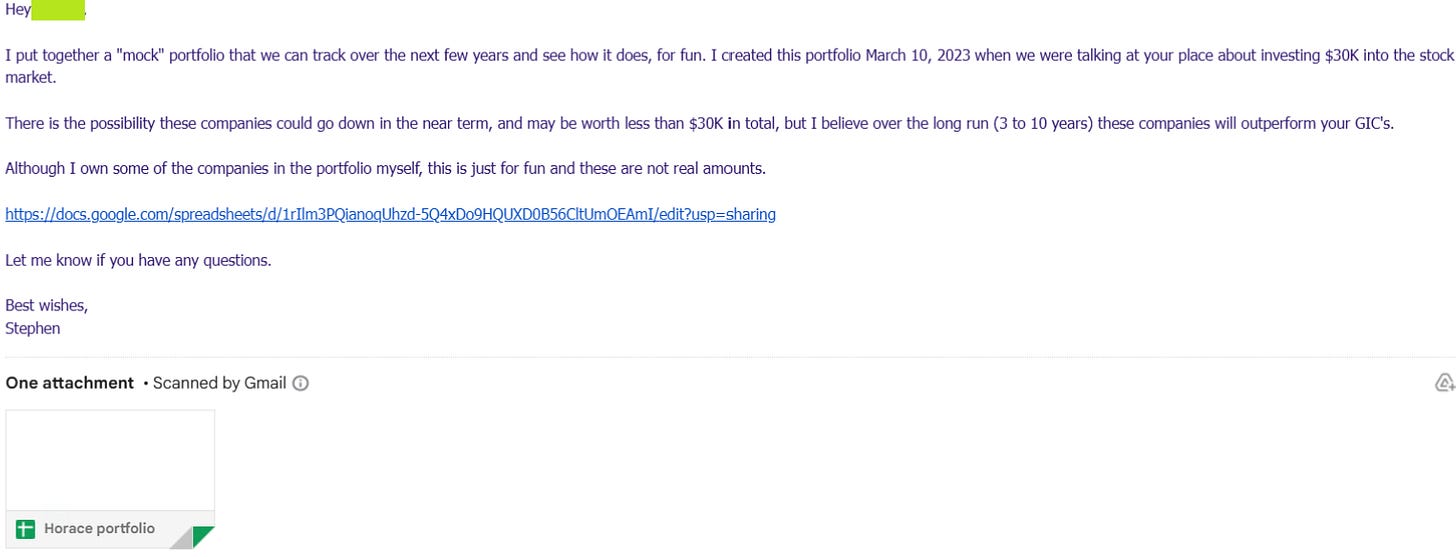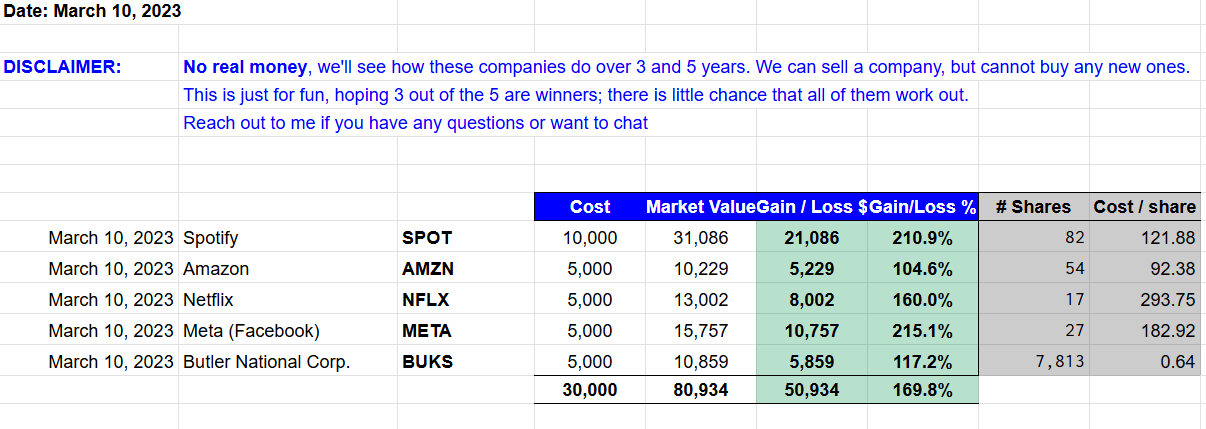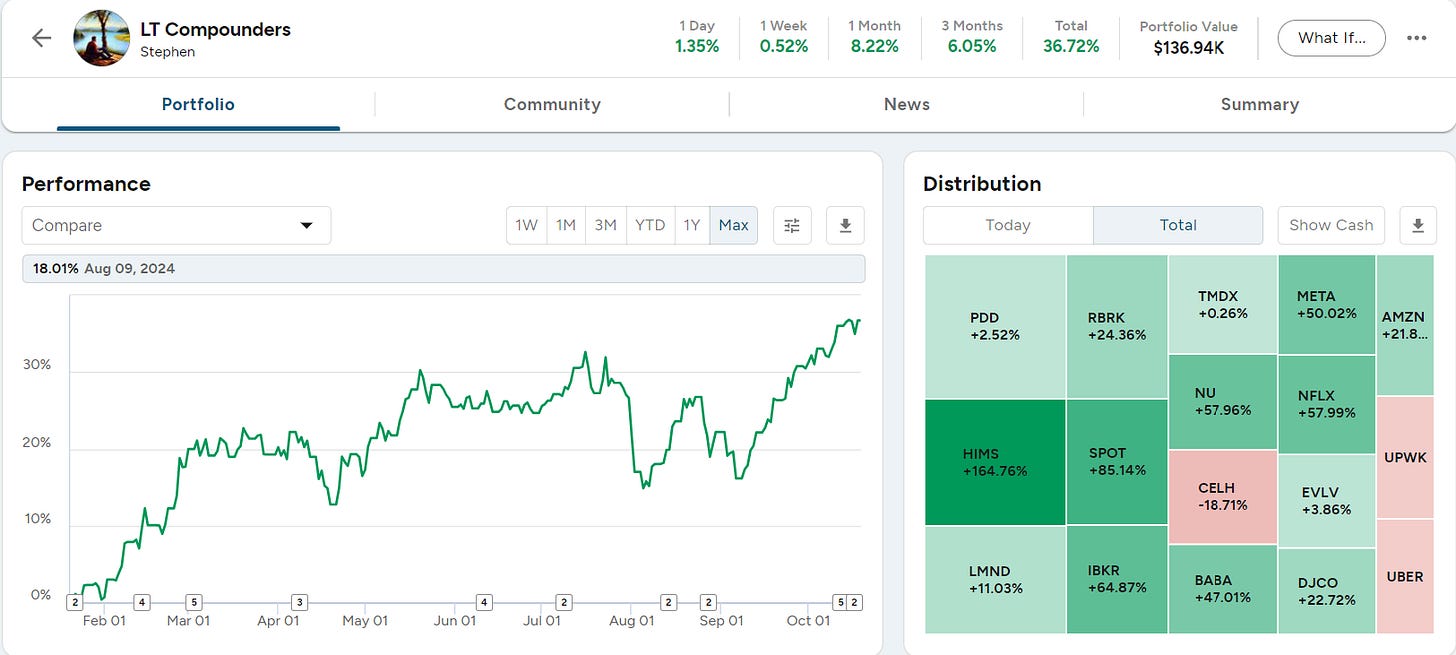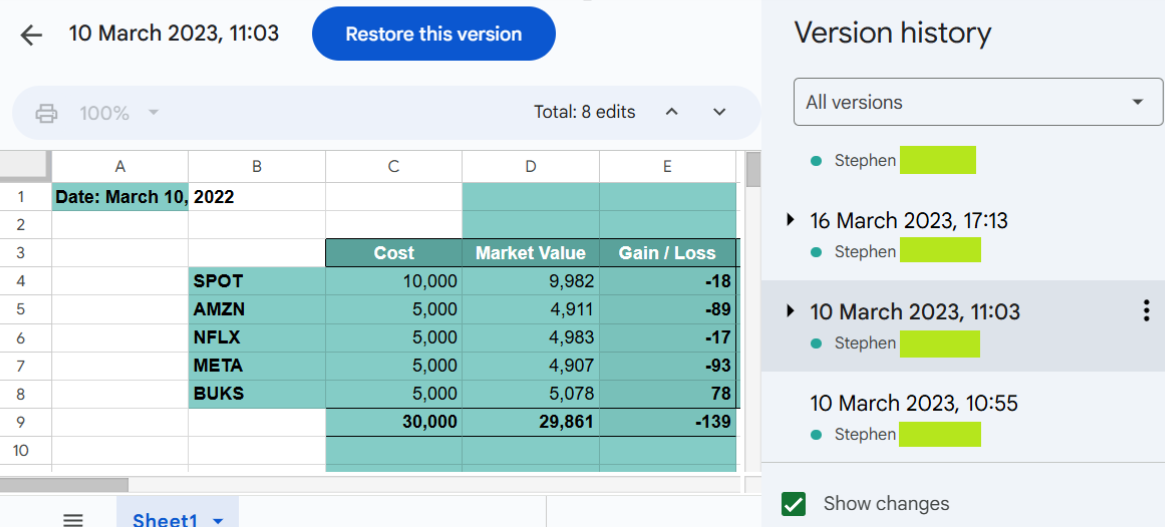I Gave Stock Picks to my Father-in-law
BONUS: Link to my Savvy Trader Long-term Compounder portfolio
Here is a link to my public portfolio in Google Sheets where I record my buy & sell activity: https://docs.google.com/spreadsheets/d/1CYey3rCG6-YsKtWJlGQQp_Ltlbatkr8q5WRwHRhpZAU/edit#gid=368928980
As a general rule, I do not recommend giving anyone stock picks. I do give picks from time to time because it’s fun, but I give a lot of disclaimers because I don’t expect to be right with every pick and you can never predict everything that will happen (e.g. black swans).
Story-time
On March 10, 2023, the S&P and Nasdaq markets had fallen by -20% and -30%, respectively, from their peaks in 2021, after steadily declining throughout 2022. Large-cap tech stocks had been hit particularly hard as interest rates rose (I know because my portfolio at the time was made up of mostly large-cap tech stocks). Market participants were selling their positions, the market sentiment was driven by fear, and here I was thinking: “this looks like a great time to pick up some deals.”
The stock market is the only market where things go on sale and
all the customers run out of the store.
— Cullen Roche
I was at my in-laws enjoying my mother-in-law’s delicious hamburgers when my father-in-law asked me about his GIC portfolio, which had been earning between 1% to 3% over the last few years and was now offering 5% for the coming year after interest rates had risen.
One thing led to another and I was pitching him on the idea of giving me a very small portion of his net worth ($30K) to invest in stocks so I could show him what kind of returns you can get with equities vs GIC’s. I wanted to keep the amount small so that it would be low risk and also keep it to an amount I could pay back if I was wrong on my picks. He declined and I was fine with that.
Later that week, I was journaling at home and started thinking about what stocks I would purchase if he had decided to go through with it. I thought we would want companies that I wouldn’t have to trade in and out of — companies we could buy and hold for years to keep it simple. I knew I wanted to diversify, but (1) with a sum of $30K I didn’t want to spread the bets too thin and (2) since it would have been a small portion of his net worth then diversification for the purpose of risk mitigation is less relevant. So I eventually landed on 5 companies.
I also thought to myself “he could still see the potential of equity returns even if it is a mock portfolio,” so I created a Google spreadsheet and e-mailed him the list I had put together. The e-mail is below:
Here is a screenshot of that spreadsheet today, including the picks and their respective values:
The original investment has almost tripled in 1.6 years, a +$51K gain on $30K.
Spotify, Amazon, Netflix, and Meta are long-term compounders which I’ve owned at different times in the past and Butler National Corp is a company I’ve written about on my blog, and currently own (BUKS costed $0.67 when I made my original post and has since doubled).
It took this portfolio 1.6 years to reach $51K in unrealized gains. Here’s how long it would have taken to achieve the same returns with GICs:
2% annual return = 49 years
3% annual return = 33 years
4% annual return = 24 years
5% annual return = 20 years
Now I’m not suggesting that a 170% return in 1.6 years is normal and repeatable. One reason for these outsized returns is because the market was near a cyclical low and investors were capitulating i.e. a portion of the outperformance can be attributed to “timing.” But in general, I believe equities will outperform GICs over most periods greater than 3 years and especially 5 to 10+ years (this statement is not regarded as controversial).
You could invest in a cheap (low-fee) index fund and out-earn GICs which is what I would recommend to most who are interested in equity-like returns. But to substantially outperform you will need to spend a lot of time researching and investing in individual equities (I do not recommend this for many).
Why don’t I have these companies in my current portfolio?
I did hold all of the stocks above throughout different periods, but the only one I still own is Butler National Corp. The others, Spotify, Amazon, Netflix, and Meta are all companies I would categorize as large-cap ‘Long-term Compounders’, here is my definition:
Long-term Compounders: an investment with a 5 to 10+ year time horizon. Plausible to hold 10+ years. Only sell if thesis is busted or there is opportunity cost to hold (much better investment elsewhere). High-level to detailed review of financial statements/KPIs each quarter. Less reliance on margin of safety than for Core investments as there is more reliance on qualitative (implicit) factors like destination analysis. A good sanity test for a compounder is that it is plausible (not necessarily probable) that the company could 5x to 10x in the next 10 years. These companies will have strong business models and could have large total addressable markets (TAM), strong management teams, and some of the strongest moats i.e. network effects, switching costs, and scale-economies-shared (low-cost) to support long-term compounding.
Even though I originally started my investment journey looking for large-cap compounders, I now focus most of my time on small and micro-caps for a few reasons:
With larger-cap compounder companies I am aiming for a 15 to 20% return per year which is great, but I believe I can consistently get higher returns in small & micro-cap. I think I have more edge (or advantage) in small and micro-caps due to less people looking at them (less competition) and I believe it is easier to grow a small company than a large one.
Here is a quick example to illustrate the last point: You could add an entire car division to Apple and it may increase the market cap by $250B or +7%. Now take a $25M market cap company, it is plausible you could add one product or big contract and double the market cap (+100%).
I believe the current valuation multiples of large-cap companies are quite high (28 P/E currently). While some argue that these higher multiples are justified due to the companies' quality, I see potential for a downward re-rating in the future (no guess on the timing). Regardless of a re-rating (short-term correction), I think the great companies will do fine over longer periods.
With all that said, I do own a few companies in my current portfolio that I would categorize as long-term compounders — designated as ‘LT’ under the ‘Type’ column. Some examples are Hims ($22), Lemonade ($18), and Trustpilot (243 GBX) (click for my original Trustpilot blog post). When I imagine the world 10 years from now, I can envision these companies being significantly larger than they are today.
Identifying companies that will grow substantially over the next 10 years is heavily reliant on making qualitative judgments of business quality (micro) and business opportunity (macro). For further reading on what implicit factors I consider, you can read my article here: https://curiousinvesting.substack.com/p/conviction-and-quality-by-josh-tarasoff
BONUS: Savvy Trader Public Portfolio
I started a couple portfolios on Savvy Trader in January of this year. I wanted to see what would happen if instead of my micro & small-cap strategy, I focused only on long-term compounders. So far I’m up 37% YTD (since Jan 20th), which is worse than I’ve done with my current micro & small-cap strategy, but one benefit of this portfolio is that it should require less activity.
Here is the link (you can view the actual positions with a free account, including buys & sells): https://savvytrader.com/Stephen/lt-compounders
A couple caveats to keep in mind:
I don’t put as much explicit research into these companies as I do my primary Google Sheets portfolio;
Re-iterating the point I made above — I believe the multiples on large-cap companies are susceptible to re-rating lower; and,
Savvy Trader doesn’t let you invest in Over-the-Counter (OTC) or international companies. So I cannot invest in companies like Trustpilot as it trades on the London Stock Exchange.
Thank you for reading and happy investing!
— Stephen
Appendix
For anyone that knows Google Sheets, here is the edit history to prove the timing of the picks:








A classic way of saying I told you so 🤣🤣🤣. Even the Mrs liked it haha.
Savvy up 39% wow and u still beat it - damn. Point illustrated. Big up to you man